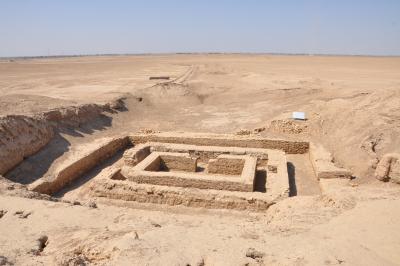Case prepared by Neil Cockerill, Patrycja Pałys and Andreas Piperides, LL.M students at Leiden University under the supervision of Professor Robert Heinsch as well as Sofia Poulopoulou and Daniel Møgster (PhD researcher/researcher), Kalshoven-Gieskes Forum, Leiden University.
A. JORDAN ACTS TO RECOVER IRAQI ANTIQUITIES
[…]
Dr Fawaz Al Khraysheh (Director of the Jordanian Department of Antiquities) noted that in the period from 2003 to 2005 Jordan has tried to limit the illicit trafficking of Iraqi artifacts. Some 1,600 Iraqi objects were seized through 23 customs and borders operations. He noted that replicas were found among the seized objects. He stressed that an inventory of those seized pieces has been submitted to both UNESCO and SBAH [State Board of Antiquities and Heritage]. He stressed that they have co-operated with ICCROM [International Centre for the Study of the Preservation and Restoration of Cultural Property], ALECSO [Arab League Educational, Cultural and Scientific Organization], ISESCO [Islamic Educational, Scientific and Cultural Organization], UNESCO [The United Nations Educational, Scientific and Cultural Organization], Japanese institutions, and other institutions and universities to organize trainings. […] He also noted that Jordan will maintain recuperated artefacts in safe keeping until Iraq requests their return. He ended his intervention by drawing attention to the fact that historic manuscripts should also be granted due attention and importance.
[…]
B. JORDAN’S SPECIALISED UNIT TO CONTROL THE ILLICIT TRANSPORT OF IRAQI ARTEFACTS
[…] In 1996, a central unit was established at the Department of Anti-narcotics, the responsibility of which is to follow up on any impacts on movable and immovable antiquities. In the meantime, there is a strict and direct cooperation between other law-enforcement agencies, Customs Departments and the Department of Antiquities of Jordan. Moreover, Cultural and Natural Heritage issues are taken into consideration as part of the study programmes of military and security departments of universities and academic sections of military forces.
During the war in Iraq in 2003, a specialized Jordanian unit was established on the Iraqi border to control the illicit transportation of Iraqi Heritage. It was very efficient and used the most developed detection machines to stop illicit transport. The Jordanian government returned hundreds of objects to Iraqi authorities, including sculptures, stamps and inscribed clay tablets.
[…]
C. JORDAN REPATRIATES ARTEFACTS TO IRAQ
[Source: The Daily Star Lebanon, Stolen artifacts trickle back to Iraq, this time from Jordan, 24 June 2008, available at: Link not available.]
[…] Jordanian authorities turned over nearly 2,500 stolen artifacts to Iraq's top antiquities official on Sunday. It was the latest in a series of high-profile events in which governments represent themselves as wanting to help war-torn Iraq recover its stolen patrimony. At a brief ceremony at Amman's Jordanian Antiquities Department contrived for the handover, Jordanian Tourism Minister Maha al-Khatib presented the pieces to Iraqi government representative Mohammad Abbas al-Uraibi.
In the last few months, Jordanian authorities claim to have seized 2,466 items as they were being taken across the border.
"The objects have been seized by Jordanian customs officials in 22 smuggling attempts," Khatib said. "All those involved have been arrested."
The handover, she continued, showed the effective measures to prevent its borders being used as a conduit for smugglers.
In the chaos following the US-led invasion of Iraq in 2003, looters snatched around 32,000 artifacts from 12,000 archaeological sites around Iraq. Another 15,000 items stolen from Baghdad's National Museum are presumed to have been smuggled out of the country. The looting plundered the country's Babylonian, Sumerian and Assyrian collections spanning some 7,000 years of ancient Mesopotamian civilization.
Amira Iidan, head of Iraq's antiquities and heritage office, said that the archaeological items recovered were rich in "human and cultural value" and belonged to periods from 7,000 to 200 BC. The most prized was an ivory relief stolen from the national museum that dates to the first millennium and came from the ancient Assyrian city of Nimrod.
[…]
Uraibi told reporters the coming days would see the recovered antiquities packed and sent back to Iraq. He said only 8,500 artifacts have been recovered, despite the introduction of a reward system offering up to $3,000 to those handing in stolen items.
Sunday's event was the latest in a series of ceremonies devoted to returning looted antiquities to Iraqi officials. In April, Syrian authorities returned about 700 stolen artifacts, including gold coins and jewelry, seized by its customs officers.
[…]
Iraqi and world culture officials have struggled to retrieve the treasures because of fears they could be lost again amid the rampant violence and the difficulties in documenting the extent of the damage.
[…]
Ancient artefacts looted from Iraq have been returned after smugglers were caught […].
Ancient Sumerian texts, pottery and glass vessels from the Babylonian era, which had been all on display at the National Museum of Iraq in Baghdad were seized in Jordan.
They are now being displayed in the Iraqi museum after neighbouring Jordan returned the precious artefacts.
Iraq's Culture Minister Abdulameer al-Hamadani said: “Iraqi heritage has suffered a lot during the last decades in terms of looting and destruction. And we believe that protecting Iraqi heritage is a global task because it's the heritage of all humankind.”
Al-Hamadani is now asking the international community to support Iraq in its quest to recover its antiquities.
The return of the artefacts came as Prime Minister Adel Abdul-Mahdi and his Jordanian counterpart Omar Razzaz revealed a new, united front.
On Saturday the border crossing between the two nations was officially reopened after a deal signed between them which includes boosted trade.
[…]
Discussion
I. Classification of the Situation and Applicable Law
1. How would you classify the situation in Iraq in 2003? Was there an armed conflict? If yes, who were the parties to it? What additional information would you need to make such a determination? (
GC I-IV, Art. 2)
II. Protection of Cultural Property
4. What constitutes cultural property? What protection does IHL provide against illicit trafficking of cultural property from the territory of countries affected by armed conflicts? Are States required to suppress the illicit transfer of cultural property? When can the export, removal or transfer of such property be considered “illicit”? What measures can be adopted to this end? (
Hague Convention of 1954 on the Protection of Cultural Property Art. 1,
2,
3,
4,
8;
First Protocol to the Hague Convention of 1954 for the Protection of Cultural Property in the Event of Armed Conflict, Paras 1,
2, 3;
CIHL, Rule 40,
41)
III. Elements Contributing to Respect for IHL
7. (Document A) What are the benefits of Jordan’s cooperation with multiple international and regional actors in order to safeguard the protection of Iraqi artefacts? Can cooperation among States contribute to respecting obligations relating to cultural property?
8. How, if at all, can the symbolic and historical value of cultural property affect States’ compliance with their obligations towards cultural property? Can public perception of harm to cultural property influence States to implement practical steps to protect cultural property in armed conflicts?
9. (Document C) Do you think that good political and economic relations with Iraq play role in Jordan’s decision to return the artefacts to Iraq?





